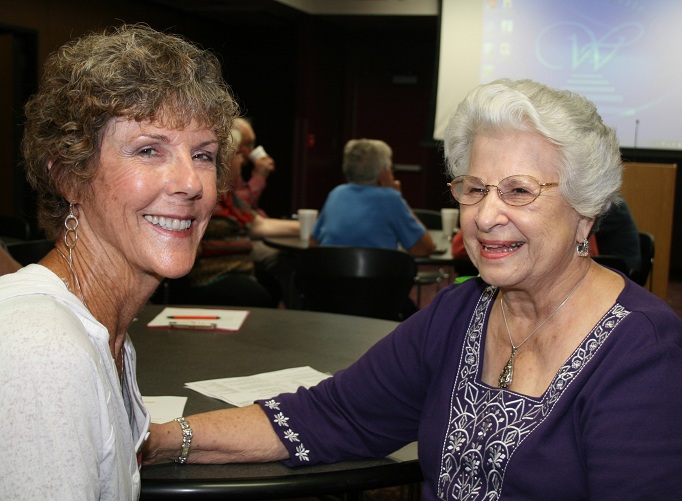Education is Key to Managing Diabetes
When Judy Burger first noticed the signs of diabetes in 1990, she was in denial. She knew the symptoms all too well after her son was diagnosed with diabetes in 1982 at the age of 15, but she wasn’t prepared to face the disease herself.
(Above) Judy Burger and Peggy Greer have developed a close friendship as they’ve attended the monthly Diabetic Support Group meetings at White County Medical
Center.
A visit to the doctor for a separate medial issue confirmed Burger’s fear: her blood sugar level was very high; she had diabetes.
“I’ve always been in good health, so it did come as a surprise,” she said. “As a child and into adulthood, I’ve always exercised and eaten a healthy diet. Of course, it was also a surprise when my son was diagnosed. He was an active teenager, and I always made sure our family meals were well-balanced.”
The main symptom she noticed was extreme thirst; also, Burger said she noticed significant hair loss, along with blurred vision and occasional incoherency and loss of focus. “Fortunately, the internist I was seeing conferred with a diabetologist, a diabetes specialist, and they collectively decided that I should take insulin shots instead of a pill.”
Originally from California, Burger and her husband Tom moved to White County, just outside Searcy, more than seven years ago. The pair are avid water skiers and sought an ideal location to settle where they could buy land, build a home and also dig a small lake. Burger said the couple continues to water ski daily when the weather is warm, and they couldn’t be happier with their decision to retire in Arkansas.
In the past, Burger benefited from the diabetes support groups her son attended. The mother and son duo created their own support system and shared thoughts and ideas about how each of them could manage their diabetes well. After attending a health fair at White County Medical Center several years ago, Burger discovered that the hospital offers a support group for those with diabetes.
Burger said she greatly appreciates the educational opportunities offered through the monthly Diabetic Support Group, led by WCMC Clinical Dietician Charlene Foster, and feels empowered to manage her diabetes successfully.
“I have learned portion control, which is really important for a diabetic,” she said. “About 99 percent of the time, I can accurately count the carbohydrates I’m eating, thanks to learning the technique of reading and understanding labels to determine what I need and what I don’t need out of a product. Also, I’ve learned more about appropriate meal plans and how much to include of what foods on a plate.”
After becoming a regular member of the Diabetic Support Group, Burger encouraged WCMC Certified Diabetes Educator Julie Smith, RN, MSN, to start an Insulin Pump Support Group for individuals – like her – who use insulin pumps to control diabetes.
At the monthly Insulin Pump Support Group meetings, Smith discusses insulin lows and how to treat those situations; new medications that can be used to treat diabetes; and, how to program a pump with the information needed to best manage insulin levels.
“Charlene and Julie have so much knowledge to offer about diabetes and how to manage it well,” Burger said. “They are a wonderful asset to the hospital for diabetics in that they provide great information about healthful eating and managing insulin/medications for those with diabetes.”
As a result of the meetings, Burger said she is eating considerably less breads and starches. “Unfortunately, I love breads and starches,” Burger admitted. “Giving up carbs is not an easy thing to do, but for me, living without carbs offers a better and healthier life. You have to decide for yourself that this is what you want to do.”
Also, since carbohydrates provide cells with needed fuel for energy, Burger has to be careful about what she eats to be able to have the energy to water ski. Often during warm-weather days, she will have an extra protein bar to give her the proper nutrition needed for the rigorous activity, otherwise she runs the risk of experiencing an insulin low.
Burger encourages those who are diabetic to wear a medical alert identification to inform others about the condition. “You never know when you might be in an accident or situation where you cannot community with others,” she said. “Even when you experience an insulin low, you may not be able to communicate effectively with others, which may lead to a misdiagnosis. I always wear a bracelet that reads ‘Diabetic’ on the back when I’m out and about.”
Successful Management through Education
Due to the prevalence of diabetes in both Arkansas and throughout the nation, the American Diabetes Association declared November as American Diabetes Month®.
White County Medical Center offers diabetes education classes and support groups to help those like Burger learn more about successfully controlling their disease. WCMC has one of only 37 recognized Diabetes Self-Management Education Classes in the state, and the only one in White County.
Diabetes has become increasingly widespread in Arkansas. The most recent information from the Arkansas Department of Health states that Arkansas has one of the highest percentages of diabetes in the nation. The disease is the sixth leading cause of death in Arkansas and the fourth leading cause of death among African Americans.
“Education is a priority,” says WCMC Certified Diabetes Educator Julie Smith, RN, MSN. “Our goal is to teach patients with diabetes the skills they need to successfully manage the disease. With this knowledge, patients have the tools to become active participants in their healthcare.”
According to the American Diabetes Association, nearly 25.8 million people in the United States — both children and adults — have diabetes and an estimated seven million individuals have not been diagnosed. Also, the disease is often considered an underlying cause of death due to the complications it can lead to, such as heart disease, stroke and kidney disease. Other health problems related to improperly managed diabetes include high blood pressure, blindness and amputations.
Types of Diabetes
According to WCMC Clinical Dietician Charlene Foster, diabetes consists of four categories: Type 1 and Type 2 diabetes; gestational diabetes, which is developed during pregnancy; and pre-diabetes.
Type 1 Diabetes is an autoimmune disease of the insulin-producing beta cells of the pancreas, which requires taking insulin daily, whether it be in pump or pill form.
“With Type 1 Diabetes, the pancreas can no longer make the insulin necessary to transport sugar from the blood into other cells for energy,” Foster said. “This form of diabetes most often develops in children and young adults; however, people over the age 40 can also develop Type 1 Diabetes.”
Nearly 95 percent of all people diagnosed with the disease have Type 2 Diabetes, which is also knows as adult-onset diabetes. Risk factors for developing Type 2 Diabetes include: obesity, an unhealthy/unbalanced diet, older age, a family history of diabetes, a history of gestational diabetes and impaired glucose tolerance and physical inactivity. Also, African Americans, Hispanic/Latino Americans and Asian Americans and Pacific Islanders are at higher risk for developing Type 2 Diabetes.
Foster said the signs and symptoms of diabetes include frequent trips to the bathroom; unquenchable thirst; losing weight without trying; weakness and fatigue; tingling or numbness in the hands, legs or feet; blurred vision; skin that is dry or itchy; and, frequent infections or cuts and bruises that take a long time to heal.
“Most often, diabetes is found when people have something else going on in their bodies and their primary care doctor does a blood test and finds that the fasting blood sugar/glucose level is high,” Foster said. “A fasting blood glucose of 70 mg/dl to 99 mg/dl is normal. If your fasting blood glucose level comes back between 100 mg/dl and 125 mg/dl, then you are considered to have impaired fasting glucose, which is also known as pre-diabetes.”
Type 2 Diabetes is preventable, and Foster said that some diabetics find that losing weight can either stop or prevent their diabetes from getting worse. “If it goes too far, individuals can end up being diabetic for life and having to take medication to manage their diabetes for their entire lives,” she added. “After being diagnosed with diabetes, patients and their doctor will be able to decide what works best for them.”
By offering the Diabetic Support Group at WCMC, Foster said the goal is to show those with diabetes how to eat better through meal planning. Also, guest speakers share tips and information on how to best manage their diabetes. Topics discussed during the monthly meetings include counting carbohydrates, reading labels, stress management, blood sugar meters, wound and foot care and staying healthy during the winter months.
“Eating the right type of food in the right portion and getting plenty of exercise such as gardening, walking, and housekeeping chores is so important to managing diabetes, as well as preventing the disease,” Foster said. “Any activity that gets your body moving is positive; a minimum of 30-45 minutes of exercise between three to five times per week goes a long way to manage and prevent diabetes.”







